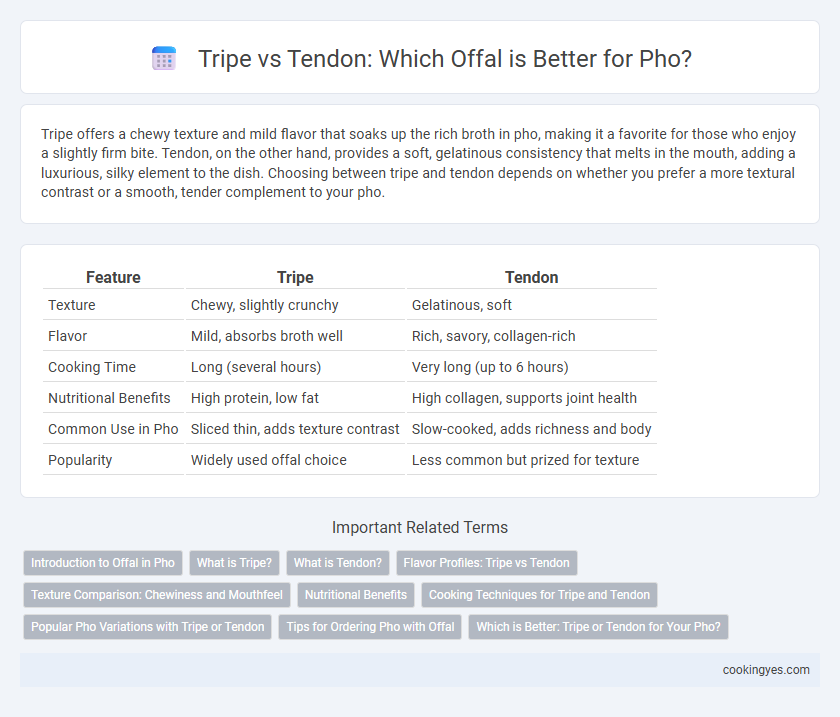Tripe offers a chewy texture and mild flavor that soaks up the rich broth in pho, making it a favorite for those who enjoy a slightly firm bite. Tendon, on the other hand, provides a soft, gelatinous consistency that melts in the mouth, adding a luxurious, silky element to the dish. Choosing between tripe and tendon depends on whether you prefer a more textural contrast or a smooth, tender complement to your pho.
Table of Comparison
| Feature | Tripe | Tendon |
|---|---|---|
| Texture | Chewy, slightly crunchy | Gelatinous, soft |
| Flavor | Mild, absorbs broth well | Rich, savory, collagen-rich |
| Cooking Time | Long (several hours) | Very long (up to 6 hours) |
| Nutritional Benefits | High protein, low fat | High collagen, supports joint health |
| Common Use in Pho | Sliced thin, adds texture contrast | Slow-cooked, adds richness and body |
| Popularity | Widely used offal choice | Less common but prized for texture |
Introduction to Offal in Pho
Pho offal features a variety of organ meats, with tripe and tendon being two of the most popular choices. Tripe, known for its chewy texture and honeycomb pattern, provides a robust, earthy flavor that contrasts with the gelatinous, tender quality of tendon. Both ingredients enrich pho broth by adding depth and complexity, making them essential components in authentic Vietnamese pho cuisine.
What is Tripe?
Tripe is the edible lining of a cow's stomach, commonly used in Pho for its chewy texture and ability to absorb the savory broth flavors. It offers a slightly grainy surface that complements the rich, aromatic spices in Pho, enhancing the overall taste experience. Known for its high protein content and unique mouthfeel, tripe is a popular offal choice that distinguishes traditional Vietnamese Pho.
What is Tendon?
Tendon in pho is a gelatinous, chewy part of the cow's leg that adds a rich texture and mild flavor to the broth. It is made of collagen-rich connective tissue that softens during long simmering, creating a unique mouthfeel that contrasts with the firmer, spongy texture of tripe. Tendon enhances the pho experience by offering a tender yet slightly resilient bite, complementing the aromatic, slow-cooked beef broth.
Flavor Profiles: Tripe vs Tendon
Tripe offers a chewy texture with a mild, slightly earthy flavor that absorbs the rich pho broth, enhancing the overall depth of the dish. Tendon provides a tender, gelatinous texture with a subtle, savory taste that adds a smooth and hearty mouthfeel to pho. Combining both tripe and tendon balances contrasting textures and flavors, elevating the pho offal experience.
Texture Comparison: Chewiness and Mouthfeel
Tripe in pho offers a distinctively firm and slightly rubbery texture, providing a satisfying chewiness that contrasts with the softer, gelatinous mouthfeel of tendon. Tendon becomes tender and almost melts in the mouth after slow cooking, delivering a smooth, rich sensation that complements the broth. The choice between tripe and tendon depends on whether you prefer a more resilient bite or a silky, tender addition to your pho.
Nutritional Benefits
Tripe in pho is rich in protein and essential minerals like zinc and vitamin B12, supporting immune function and energy metabolism. Tendon provides a high collagen content, beneficial for joint health and skin elasticity. Both offals are low in fat, making pho a nutritious choice for a balanced meal.
Cooking Techniques for Tripe and Tendon
Tripe and tendon require distinct cooking techniques to achieve the perfect texture for pho offal. Tripe is often blanched and simmered slowly to soften its chewy consistency while maintaining a slightly firm bite. Tendon needs prolonged boiling, often several hours, to break down collagen into gelatin, resulting in a tender, melt-in-the-mouth texture ideal for pho broth.
Popular Pho Variations with Tripe or Tendon
Popular pho variations often feature either tender beef tripe or soft beef tendon as key offal ingredients, each offering unique textures and flavors that cater to different preferences. Tripe, known for its chewy, honeycomb-like texture, is commonly preferred in northern Vietnamese pho recipes, while tendon, prized for its gelatinous, melt-in-the-mouth quality, is favored in southern styles. Both offal types enhance pho's rich broth by introducing distinctive umami notes, making them staples in traditional and modern pho dishes across Vietnam.
Tips for Ordering Pho with Offal
When ordering pho with offal, choosing between tripe and tendon depends on texture preferences: tripe offers a chewy, honeycomb texture while tendon provides a soft, gelatinous bite that melts in the mouth. Request well-cleaned tripe to ensure a mild, non-gamey taste, and opt for slow-cooked tendon to enjoy its rich collagen benefits and smooth consistency. Specify your preferred mix to balance the flavors and textures, enhancing the traditional pho experience with authentic offal components.
Which is Better: Tripe or Tendon for Your Pho?
Tripe and tendon both add unique textures and flavors to pho, but tripe offers a tender, mildly chewy bite with a slightly earthy taste, making it a favorite for those who enjoy a richer offal experience. Tendon provides a gelatinous, melt-in-your-mouth texture that enhances pho's broth with a subtle savory depth while being easier to digest. Choosing between tripe or tendon depends on personal texture preferences and the desired balance of flavor complexity in your pho.
Tripe vs Tendon for Pho offal Infographic

 cookingyes.com
cookingyes.com